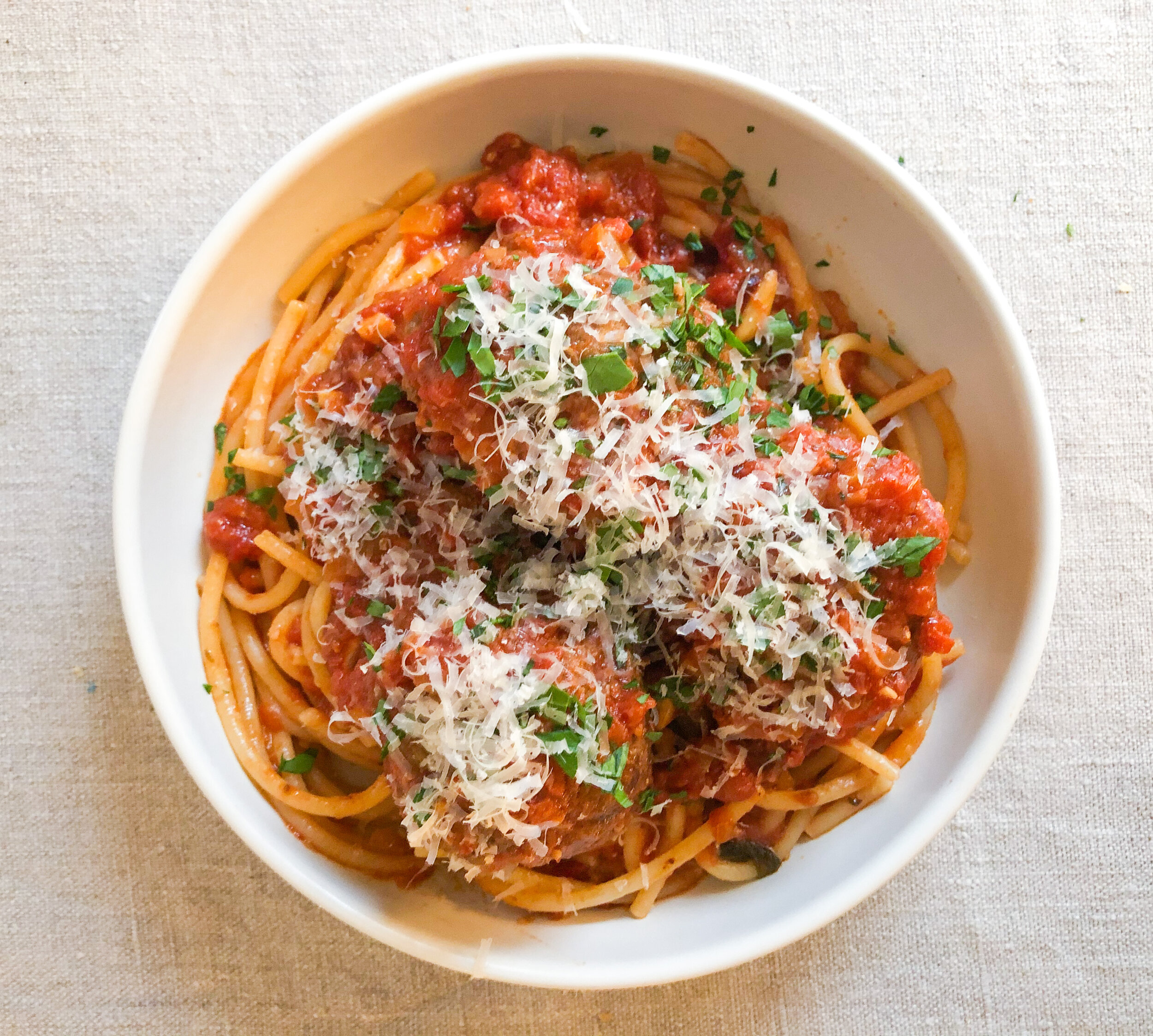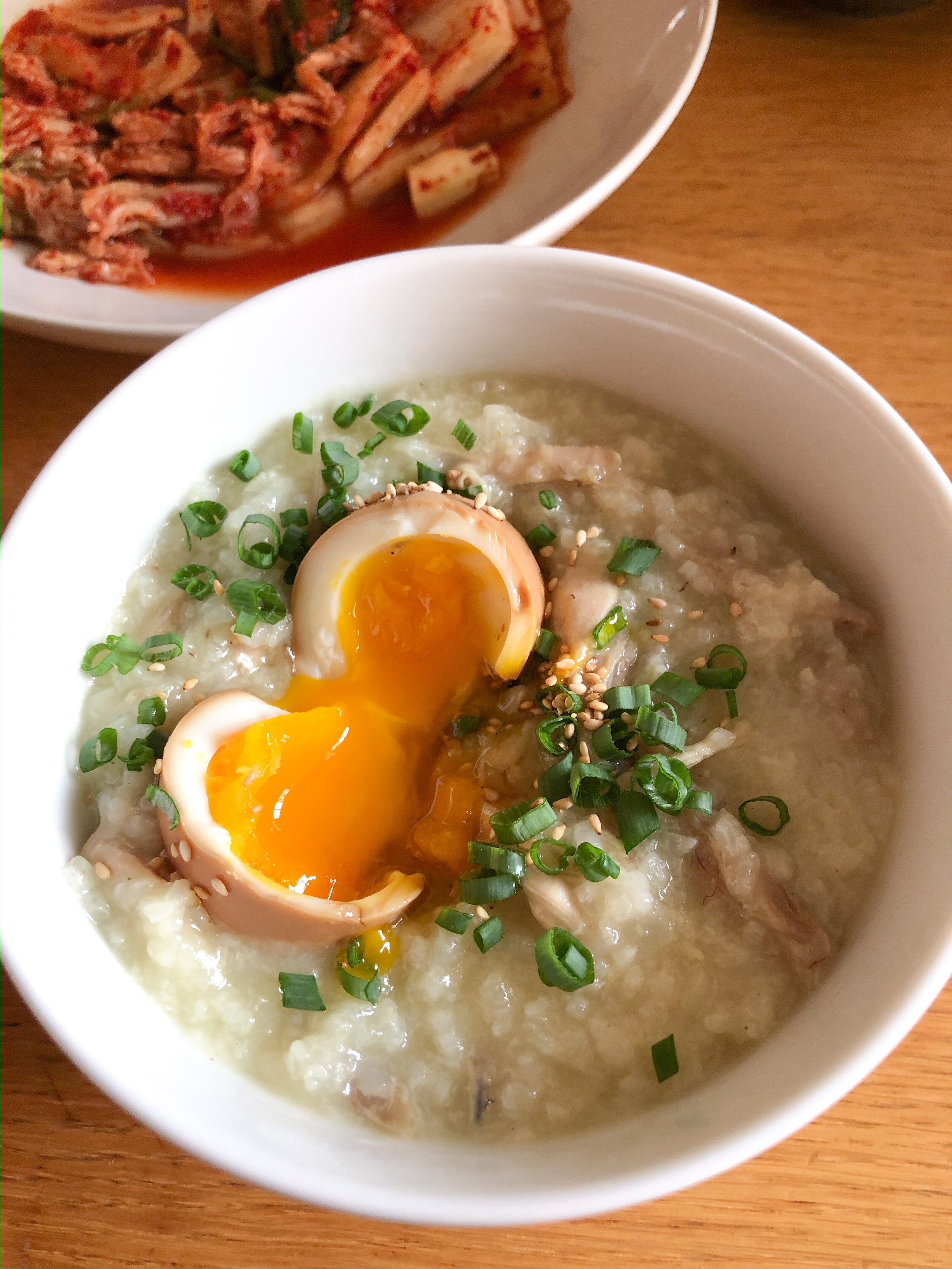Updated: September 26, 2025 (I updated the meatball cookery and gave you an option to bake instead of fry the meatball, and I added the 3oz. ice cream scoop as a tool to quickly scoop and shape the meatballs.) I also sent this recipe out in an old newsletter that I recently reread and loved. Here it is if you’re interested in reading this essay.
—
I rarely needed to make meatballs and red sauce in NYC, but it was always a special occasion food and a weekend project to look forward to when I did. I would go to Paisano's or Fleisher's butchers to get some high-quality beef, pick up some crusty bread, and cook while listening to a podcast or NPR. I'd make the meatballs, sear them up, and finish them in a simple red sauce. Then, we'd have friends come over to tuck into the pasta.
I was hesitant to write a recipe because I'm not Italian, and I don't want to be appropriative. But, folks reach out to request the recipe when I shared stories of it on IG. I want to be clear that this is my interpretation and instructions of a classically Italian-American dish that draws from many wonderful Italian cookbooks, chefs, restaurants, and friends. I hope to share what I've learned from these wonderful traditions and voices in a respectful and not appropriative way. The most impactful inspiration to my current version of meatballs comes from the meatballs served at Frankies 457 in Brooklyn; they're huge, juicy, and come three to a small plate piled with red sauce filled with pine nuts and raisins. I'll always remember how succulent and juicy the meatball was, how the raisins had plumped in the juices to add a touch of sweetness to each bite, and how the pine nuts added savory morsels of opulence. The version of meatballs and red sauce that I make today, in 2020, has evolved over a couple of decades of making this dish. It might be one of the foods that I first learned how to cook, a food that I have a history with, and is incredibly comforting and reminds me of friends and family. You can read part two about Spaghetti and Meatballs in the November newsletter coming out tomorrow. If you haven't already, subscribe!
This recipe makes 18 meatballs, which can serve up to six people. You can split the recipe in half. Or, cook the full recipe and freeze a portion of it for up to two-months. Thaw the sauce in your fridge overnight and reheat over medium-low heat for 20-30 minutes. I like to make the whole batch at once and eat the meatballs throughout the week in various iterations: on a sandwich with melted cheese, alongside vegetables, or with pasta.
Recipe Type: Dinner/project
Time: 2.5-3 hours
Servings: 6 servings
Ingredients
Meatballs
¼ cup pine nuts
½ cup of bread crumbs or 1½ cup of day-old bread (any kind) with crusts removed torn or cubed into 1-inch pieces
½ cup of milk
2 lbs or 900 grams of ground beef with about 10% fat
One medium onion diced into ¼ inch pieces
4-5 cloves of garlic finely chopped
¼ cup of chopped parsley
½ cup of golden raisins
One tablespoon zest from an orange or a lemon
Three eggs
½ cup of grated Parmesan or Pecorino cheese
One teaspoon freshly grated nutmeg
Salt and pepper
1 cup of neutral oil for frying
Red Sauce
One medium onion diced into ½ inch pieces
4-5 garlic cloves minced
Two 28-oz cans of whole peeled plum tomatoes
One teaspoon oregano
One teaspoon crushed red pepper
Olive oil
1-2 teaspoons granulated white sugar
Two one-pound packs of spaghetti
For serving
Finely chopped parsley
Parmesan for grating on top of the pasta
A big green salad
Equipment
Mixing bowls
Measuring cups
3 oz. ice cream scoop (optional)
Chopping board/knife
Frying pan or skillet
Large pot for boiling pasta
Large heavy-bottomed pot for red sauce
Tongs
Small sheet tray
Instructions
Preparing meatballs is one of those meditative tasks that takes a little bit of practice to master. Take it easy and be kind to yourself if this is your first time making them. They're kind of like learning how to fold dumplings. The more you do it, the better and faster you'll get at making them. Think of this as an opportunity to listen to your favorite podcast or an audiobook while you're cooking. For an enjoyable time in the kitchen, set yourself up for success by reading through the instructions before cooking, preparing your mise en place, and cleaning as you go!
Toast Pine Nuts and Soak Bread Crumbs
Place the pine nuts on a small sheet tray and toast in a preheated 350℉ 175℃ oven and set a timer for 4 minutes at first and keep adding a minute to the time until they're lightly golden and fragrant. Keep your eye on the oven because the nuts will go from toasted to burned in seconds. Pull from the oven and let cool on a wire rack.
Soak bread crumbs or the cubed or torn bread into the milk in a bowl for around 5-10 minutes.
Meatballs
Add the ground beef to a large mixing bowl.
Peel two onions and toss the skins. Chop the first onion into a ¼ inch dice for the meatballs into the mixing bowl with the meat. Chop the second onion (for the gravy/sauce) into a ½ inch dice and set aside in a small bowl.
Mince 8-10 cloves of garlic. Add half of the garlic to the mixing bowl with the meat, and set aside the other half in a small prep bowl.
Mince ½ cup of parsley, add half into the mixing bowl with the meat, and reserve half in a small prep bowl for garnishing later.
Chop half of the raisins into smaller pieces and leave the rest whole. Add all of the raisins to the mixing bowl with the meat mixture along with one teaspoon of grated nutmeg, one teaspoon orange zest, the toasted pine nuts, two eggs, ½ cup of grated parmesan, one teaspoon of grated nutmeg, and soaked bread or bread crumbs. If you've soaked the cubed bread, crumble the bread into small pieces (the size of peppercorns) and add to the meat mixture along with the residual milk.
Season with one tablespoon of kosher salt (adjust to half a tablespoon if you're using table salt) and 8-10 grinds of fresh pepper (or around one teaspoon of pepper).
Mix the meat mixture by hand for 2-3 minutes until thoroughly combined.
Heat the skillet and add a ½ inch layer of oil to the bottom of the pan. Take one teaspoon of meat and form it into a little hamburger patty. When the oil heats up, fry it until cooked, and taste it for seasoning. You'll most likely need to add more salt. Make another patty and fry it to taste the seasoning, and continue doing that until seasoned to your liking. Turn off the skillet while you form the meatballs.
Using a ⅓ cup measuring cup or a 3 oz ice cream scoop, scoop ⅓ cup meat portions into your hand and tightly form into round balls. Place on a baking sheet.
Heat the skillet, and when the oil is hot (when you place a meatball in the oil, it should have a nice sizzle), fry the meatballs in a pan, taking care not to overcrowd the pan. Leave 2-3 inches around each meatball. Let each face of the meatball sear and get a deep brown crust. Once one part of the meat gets a crust, I like to use two spoons to gently roll the meatball onto another face of the ball to sear that side and do that until all the meatball sides are seared.
Getting a good sear on the meatball is crucial to adding flavor and preventing it from falling apart in the sauce. You don't need to worry about cooking the meatball all the way through because it will finish cooking in the sauce.
Alternatively, if you do not want to go through the ordeal of frying, I found that placing the meatballs on a quarter baking sheet and baking them at 400°F/205°C in a convection oven (for 30 minutes) or a standard oven (for an hour) browned and sufficiently held the meatballs together.
Sauce
In a large heavy-bottomed pot (I use a 7-quart Dutch oven to prevent the sauce from burning), add 3-4 tablespoons of olive oil and heat the pan. Once the oil is hot, add the reserved ½" diced onion for the sauce and cook for two minutes or until they become translucent. Then, add reserved minced garlic and cook until the garlic is fragrant and translucent (a minute or two). Take care not to brown the onion or garlic.
Add one teaspoon of crushed red peppers and toast for 30 seconds or so.
Add one teaspoon of oregano to your palm and rub your hands together over the pot to release the oils. Add the oregano to the pot.
Add the canned tomatoes by taking the tomatoes two at a time and crushing them and breaking them into tiny pieces with your hands over the pot. Then add the liquid from the cans and rinse out the cans with some water and add that rinsed tomato water to the pan. Add one teaspoon of sugar and a generous pinch of salt, and 3-5 grinds of pepper. Bring the sauce to a boil, then lower to a gentle simmer.
Simmer for 30 minutes over medium-low heat. You want the sauce to have a gentle and consistent boil. Stir it every 5 minutes or so to make sure it's not scorching or sticking to the bottom of the pan.
After the sauce has cooked for 30 minutes, lower the heat slightly, gently add the meatballs into the sauce and cook for 30 more minutes. Stir occasionally to make sure the sauce isn't sticking to the bottom of the pan.
Bring a pot of water to boil, and keep it hot on the stove over low heat. During the last 10 minutes of meatball cooking, cook the spaghetti for two minutes less than the suggested time. Before draining the pasta, save one cup of pasta boiling liquid (I use a measuring cup and scoop from the pot), then drain the spaghetti in a colander in the sink.
Immediately add the pasta back to the same pot plus half a cup of pasta water. Spoon in a cup or two of sauce (no meatballs) and cook the pasta, sauce, and pasta water, stirring gently together until cooked al dente. The pasta will continue cooking and absorbing the liquid.
Add more sauce and pasta water as you need to have a nice glossy sauce. Remove from heat, add to a large pasta bowl or individual bowls. Ladle more sauce on the pasta and place the meatballs on top. Garnish with chopped parsley.
How to Serve
Serve family-style or in individual bowls. I like to serve three meatballs per person.
Serve with crusty bread and a big green salad.




















